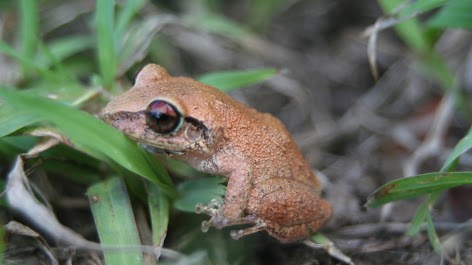
The Great V.I. Frog Count is underway, bringing citizen science to the territory’s fingertips in an easy and accessible way.
Herpetologist Renata Platenberg started the V.I. Frog Count in 2015 to enhance frog monitoring in the territory. According to Platenberg, anyone with a smartphone or recording device can participate by simply sending a two-minute audio recording with the recorded site’s GPS coordinates. By listening for the unique calls of frog species, Platenberg is then able to pinpoint exactly which species are where.
“I came up with the idea on a Wednesday, and then launched it on a Friday,” said Platenberg. I didn’t know if it would work at all.”
According to Platenberg, before 2015 maybe 30 sites on St. Thomas were monitored in a season, but “after this effort [The Frog Count] we were able to get 300 sites in the first year from five different islands.”
“They’re important indicators of ecosystem environmental quality, and functions,” Platenberg said of the value of understanding and protecting frog populations.
According to Platenberg, mapping the location of frogs can be helpful to biologists in tracking the impacts of things such as pesticides, urban development and even acoustic influences.
“You can hear things like, cars, tvs, dogs. The frogs can tolerate some level of development, but the question is where is that threshold where your human influence starts to degrade the environment such that your frogs disappear,” said Platenberg.
Along with better understanding human impact on frog populations, mapping the distribution of frog populations is important to biologists to better understand things like what frog species are associated with each other, and the distribution of invasive species such as the Puerto Rican Coqui.
“I’ve learned that even with its limited dispersal opportunities, the Puerto Rican Coqui has been able to move out of its limited distribution and is now pretty much all over the place,” said Platenberg.
To participate in the V.I. Frog count, you can follow the steps listed below provided by the V.I. Children’s Museum.
1.) Locate or download a voice recorder app on your phone. Be sure to adjust the sound quality to “high” or set the mic to “meetings and lectures.”
2.) Go outside between 7-9 p.m. (between Oct. 1-15) as far away from human noise as possible. It’s ok if you don’t hear frogs; that is also a useful indication.
3.) Take a two-minute recording using the voice recorder app.
4.) Save the recording with the name of your location including which island. (i.e. Buccaneer Mall, St Thomas)
5.) Using Google Maps, drop a pin on your location and copy to clipboard. (You may need to zoom closer to your exact location to increase the accuracy of your pin.)
6.) Email the recording and the pin (GPS coordinates) to vi.frogcount@gmail.com.
7.) That’s it! Congratulate yourself for contributing to science! Feel free to create recordings from other locations.